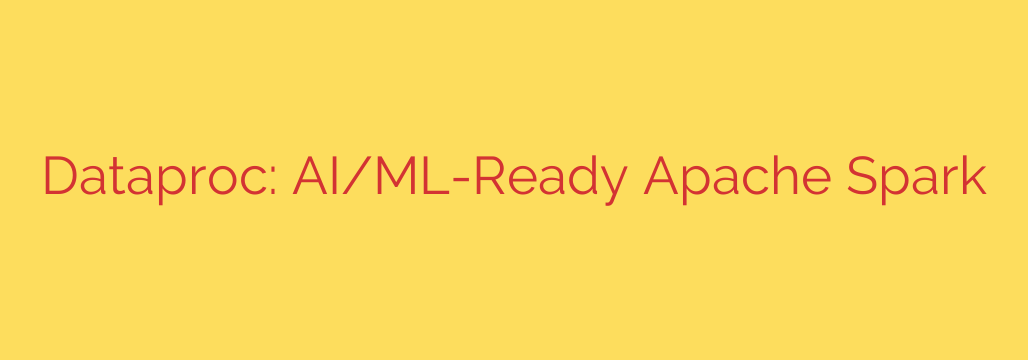
Supercharge Your AI/ML Workloads: The Power of Managed Apache Spark
In the world of big data, Apache Spark stands as a titan. Its power for large-scale data processing and analytics is unmatched, making it the go-to framework for everything from complex ETL pipelines to sophisticated machine learning models. However, harnessing this power often comes with a significant challenge: the immense operational overhead of deploying, managing, and scaling a Spark cluster.
For data science and engineering teams, time spent on infrastructure management is time not spent on building value. This is where managed Spark platforms have become a game-changer, providing a streamlined, AI- and ML-ready environment that accelerates development from start to finish.
The Burden of Self-Managed Spark
Before diving into the solution, it’s crucial to understand the problem. Running a self-managed Apache Spark environment on-premises or on raw cloud infrastructure requires deep expertise. Teams must handle:
- Complex Setup: Provisioning virtual machines, installing Spark and its dependencies, and configuring network and security rules.
- Constant Tuning: Optimizing memory, CPU, and storage settings to prevent bottlenecks and ensure performance.
- Manual Scaling: Adding or removing nodes to match fluctuating workloads, a process that is often slow and inefficient.
- Security and Maintenance: Patching vulnerabilities, updating software, and ensuring the cluster remains secure and compliant.
These tasks are not only time-consuming but also distract from the primary goal: extracting insights and building intelligent applications.
Simplify and Accelerate with Managed Spark Services
Managed Spark services are designed to eliminate this operational complexity. By providing a fully managed environment, these platforms empower teams to launch and run Spark jobs in minutes, not days. The core benefits are transformative.
First and foremost is the simplified cluster management. With a few clicks or a single API call, you can deploy an optimized Spark cluster pre-configured with the tools you need. This automated provisioning removes the guesswork and human error associated with manual setups.
Equally important is intelligent autoscaling. Instead of manually adjusting resources, a managed platform can automatically scale the number of worker nodes up or down based on the real-time demands of your job. This ensures you always have the performance you need without paying for idle resources, leading to significant cost savings.
Building a Foundation for Advanced AI and Machine Learning
The true power of a managed Spark environment shines when applied to AI and machine learning workloads. These platforms are purpose-built to integrate seamlessly with the modern data science toolkit.
GPU Acceleration on Demand: Training deep learning models often requires the immense parallel processing power of GPUs. Managed services make it incredibly easy to provision clusters with powerful GPUs (like NVIDIA A100s), dramatically reducing training times for frameworks like TensorFlow, PyTorch, and RAPIDS.
Pre-Configured Environments: Say goodbye to dependency headaches. Managed platforms often come with pre-built images that include popular AI/ML libraries, Jupyter notebooks, and other essential tools. This means data scientists can start coding and experimenting immediately in a consistent and reproducible environment.
Seamless Component Integration: Modern data pipelines are rarely just about Spark. A robust managed service offers easy integration with other critical components of the big data ecosystem, such as Hadoop Distributed File System (HDFS), YARN for resource management, and Hive for data warehousing. This flexibility allows you to build comprehensive, end-to-end data solutions.
Key Security and Efficiency Tips for Your Spark Workloads
To maximize the benefits of a managed Spark environment, it’s essential to follow best practices for security and efficiency.
Implement Fine-Grained Access Control: Use Identity and Access Management (IAM) policies to enforce the principle of least privilege. Grant users and service accounts only the permissions they absolutely need to perform their jobs, reducing your security risk.
Enable Data Encryption: Security is non-negotiable. Ensure that data is encrypted both at rest (in storage) and in transit (as it moves across the network). Managed platforms often make this as simple as checking a box during cluster configuration.
Right-Size Your Jobs and Clusters: While autoscaling helps, it’s still important to define sensible minimum and maximum cluster sizes. Analyze your job requirements to choose the right machine types and resource configurations to balance performance and cost effectively.
Leverage Serverless Options: For intermittent or unpredictable jobs, consider using serverless Spark. This next-generation approach allows you to run Spark code without provisioning or managing any clusters at all. You simply submit your job and pay only for the exact resources consumed, offering the ultimate in convenience and cost efficiency.
Conclusion: Focus on What Matters Most
Ultimately, managed Apache Spark platforms are about shifting focus. They handle the complex, undifferentiated heavy lifting of infrastructure management so your data engineers and data scientists can concentrate on what they do best: building powerful models, uncovering critical insights, and driving business value. By abstracting away the operational burden, these services not only accelerate project timelines but also foster a culture of innovation, empowering your team to push the boundaries of what’s possible with AI and machine learning.
Source: https://cloud.google.com/blog/products/data-analytics/dataproc-features-enable-aiml-ready-apache-spark/








